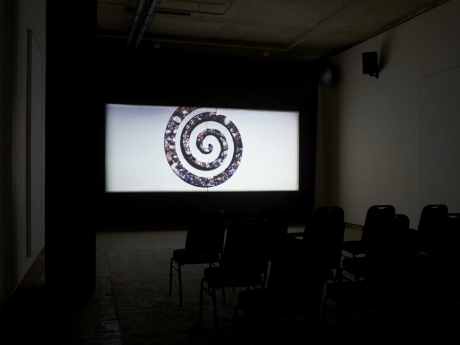JG
You and Me and the Continuum
Deep cover cultural assignments and obsessional detritus
Tag Archives: Robert Smithson
JG supplements
Tacita Dean’s film JG, opening today at the Frith Street Gallery, was inspired by a correspondence with J.G. Ballard shortly before his death from cancer in 2009. Dean was interested in the connections between Ballard’s short story ‘The Voices of Time’ (1960) and Robert Smithson’s masterpiece, Spiral Jetty (1970), a 1500 ft earthwork built into the Salt Lake in Utah. Ballard urged Dean to ‘treat [Spiral Jetty] as a mystery that your film will solve.’ I’ve not been able to make it in to see the film yet but Ballard’s papers are archived at the British Library so I spent some of yesterday nosing around in them.

I’m attempting to hawk around paying print outlets a piece based on that archival cratedigging, so won’t post it here until next week, but here’s some useful contextualising material. Ballard sent Dean the text of his short piece ‘Robert Smithson as Cargo Cultist’ (printed on the back of a proof page from Millennium People). This is published in Conley, Brian, and Joe Amrhein, Robert Smithson: A Collection of Writings on Robert Smithson on the Occasion of the Installation of ‘Dead Tree’ at Pierogi 2000 (Brooklyn, NY: Pierogi 2000, 1997) but is nowhere online, so with apologies to the publishers, here it is:
What cargo might have berthed at the Spiral Jetty? And what strange caravel could have emerged from the saline mists of this remote lake and chosen to dock at this mysterious harbour? One can only imagine the craft captained by a rare navigator, a minotaur obsessed by inexplicable geometries, who had commissioned Smithson to serve as his architect and devise this labyrinth in the guise of a cargo terminal.
But what was the cargo? Time appears to have stopped in Utah, during a geological ellipsis that has lasted for hundreds of millions of years. I assume that that cargo was a clock, though one of a very special kind. So many of Smithson’s monuments seem to be a patent amalgam of clock, labyrinth and cargo terminal. What time was about to be told, and what even stranger cargo would have landed here?
The Amarillo Ramp I take to be both jetty and runway, a proto-labyrinth that Smithson hoped would launch him from the cramping limits of time and space into a richer and more complex realm.
Fifty thousands years from now our descendants will be mystified by the empty swimming pools of an abandoned southern California and Cote d’Azur, lying in the dust like primitive time machines or the altar of some geometry obsessed religion. I see Smithson’s monuments belonging in the same category, artefacts intended to serve as machines that will suddenly switch themselves on and begin to generate a more complex time and space. All his structures seem to be analogues of advanced neurological processes that have yet to articulate themselves.
Reading Smithson’s vivid writings, I feel he sensed all this. As he stands on the Spiral Jetty he resembles Daedalus inspecting the ground plan of the labyrinth, working out the freight capacity of his cargo terminal, to be measured in the units of a neurological deep time. He seems unsure whether the cargo has been delivered.
His last flight fits into the myth, though for reasons of his own he chose the wrong runway, meeting the fate intended for his son. But his monuments endure in our minds, the ground plans of heroic psychological edifices that will one day erect themselves and whose shadows we can already see from the corners of our eyes.
I’d also like to draw attention to Eric Saxon’s MA thesis which is a nice piece of scholarship on precisely this relationship; and Smithson’s essay ‘Quasi-Infinities and the Waning of Space’ (1966, sadly a bit difficult to read in this form). There’s also a really solid article by Andrew Frost at ballardian.com. Suffice to say there is much to be read and thought around this relationship.
